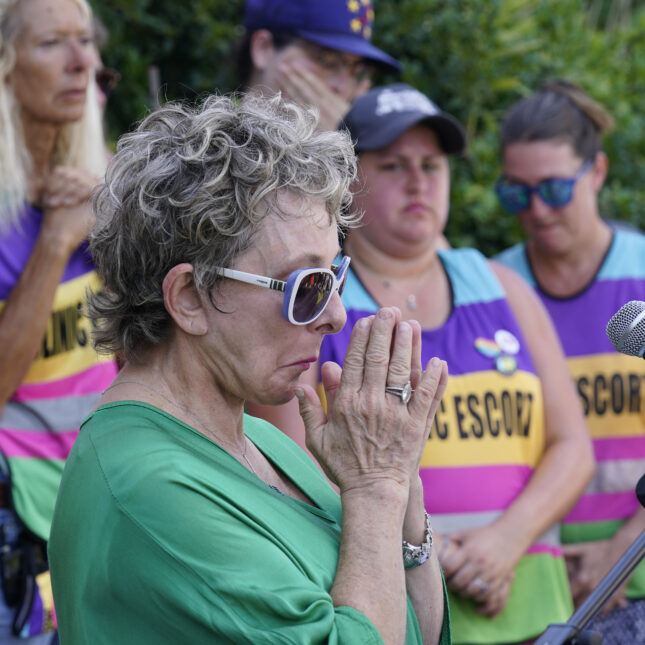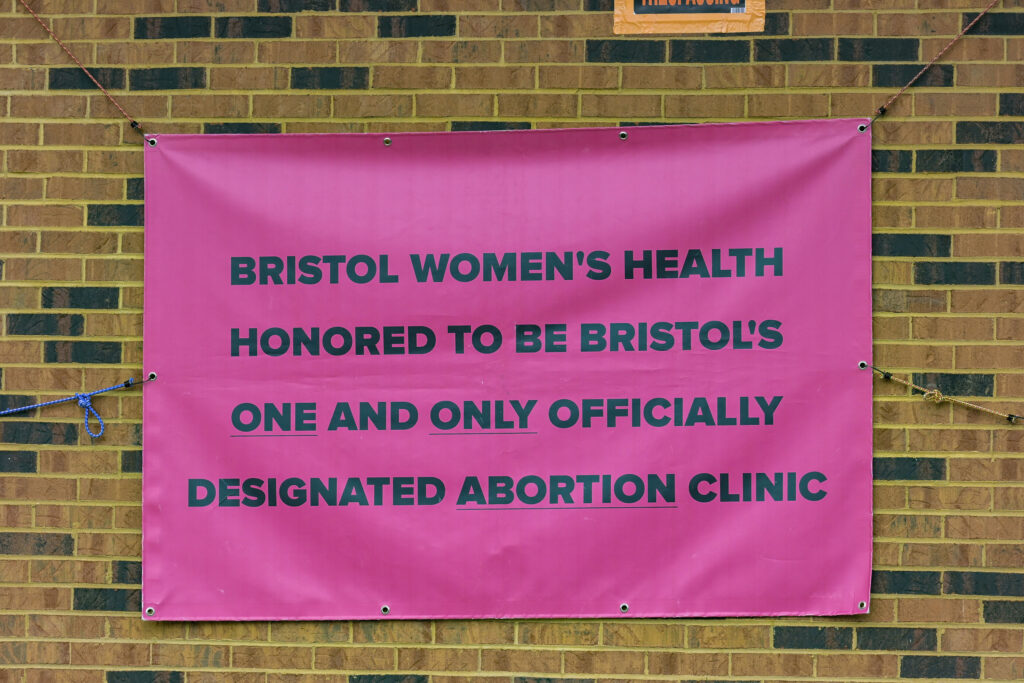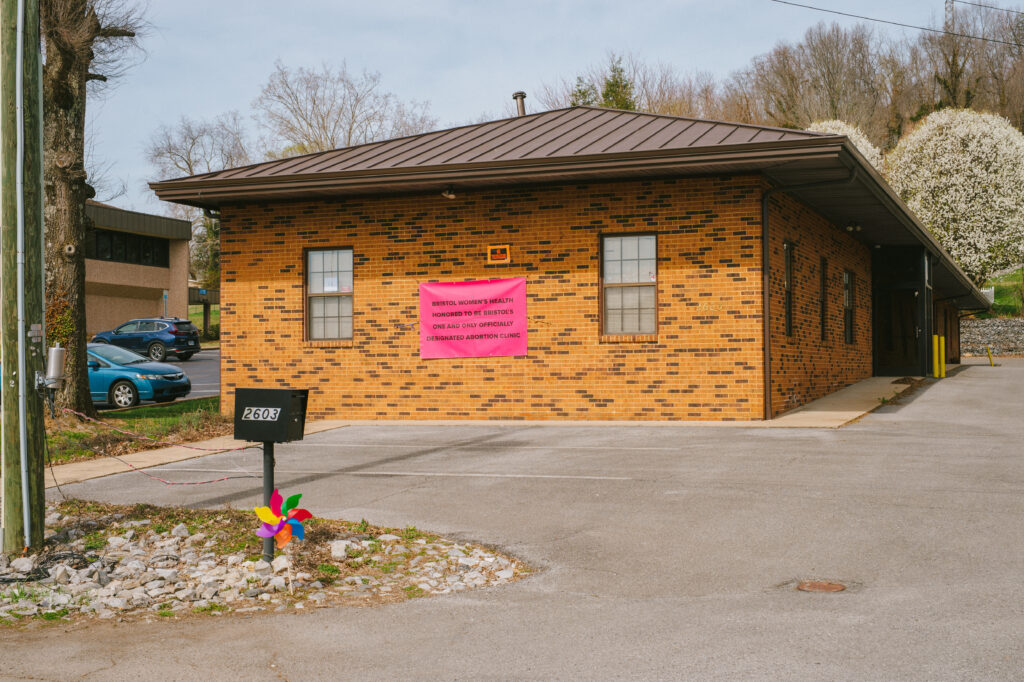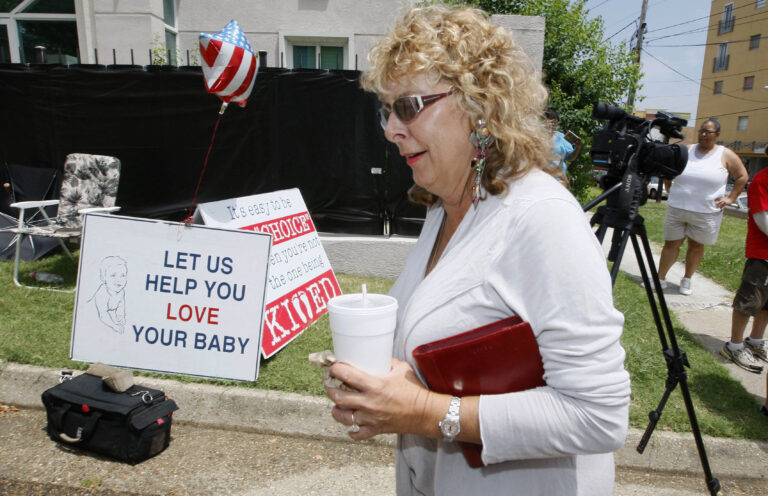
BRISTOL, Va. — Stephanie Rosenwinge was excited to work for the queen of abortion. She’d grown up in rural Virginia with an abusive, alcoholic father. Her mother had had an abortion in 1973, and it may have saved her life: As Rosenwinge put it, “My dad was determined to beat the baby out of her.” Rosenwinge herself had been sexually assaulted while serving in the Gulf War, and she was glad she would’ve had a constitutional right to terminate had the attack resulted in a pregnancy. Then, after discharge, she and her husband chose to exercise that right: She was pregnant, uninsured, in a mental health crisis, and in no position to have a kid.
That was partially why she started volunteering outside an abortion provider’s office in Bristol, Tenn. — and when Roe was overturned last year and Tennessee’s ban took effect, she was thrilled to accept a job at the new abortion clinic opening up right across the state line, in Bristol, Va.
The business belonged to Diane Derzis — a name Rosenwinge knew. Derzis was one of the loudest, most recognizable voices of the abortion rights movement. She’d started working in the field in the 1970s, and had gone on to run clinics in some of the most hostile states. One, in Alabama, was bombed in 1998. Another, in Mississippi, was at the center of the U.S. Supreme Court case that overturned Roe. She currently has four clinics, and is planning more. “The abortion queen,” she’s often called.
“The first time I met her, I told her, ‘For me, this is like meeting a movie star,’” Rosenwinge said. “’For me, it’s like meeting my hero.’”
But she soon began to have qualms about her new boss.
She was alarmed, she said, when Derzis told staff to cut back on financial aid information they were giving patients — and later, when she instructed them to make sure that patients were paying at least something out-of-pocket, even if abortion funds had agreed to cover that person’s entire bill. “She said, ‘I want these patients to have some skin in the game. They shouldn’t be fully funded,’” recalled Rosenwinge, who quit this past June.
Other staff members had similar concerns. “Us on the frontline, seeing patients, seeing their emotion, seeing how much they struggle, we are witnessing how terrible it might be for them,” said Olivia Nickels, who also quit her job at Bristol Women’s Health in June. “So being told not to provide [full] financial assistance information to those patients was a stab in the gut, to be totally honest.”
The reproductive rights movement is often loath to criticize its own. With so many restrictions already in place, advocates worry that publicly airing internal disputes might give anti-abortion activists more fodder and end up doing more harm than good. Patients regularly travel hundreds of miles to seek care in Bristol — just one example of the importance of a single clinic. But in this case, former employees spoke out in part because they worried that a business that ostensibly exists to ensure abortion access had a guiding principle that might be restricting it.
“So being told not to provide [full] financial assistance information to those patients was a stab in the gut, to be totally honest.”
Olivia Nickels
Derzis doesn’t see it that way. Derzis acknowledged giving these sorts of directives, but said the clinics make exceptions if patients really can’t pay anything. She said she wanted to ensure that abortion funds’ limited resources were used wisely. “They were having women have free abortions,” she told STAT. “They are not only using all the money, but every woman did not need to have financial assistance. The purpose of funding was to make sure there was money there for people who needed that.”
It was also a cash flow issue, she explained. Rather than paying a clinic immediately to subsidize a patient’s care, some abortion funds send one monthly check. But Derzis said they’re often very, unworkably late. “I’ve got $32,000 coming in from one funder. And the check is supposed to be here this week. Check’s in the mail, right? Check’s in the mail. It’s been owed for five months. That’s unacceptable,” she said, adding “I’m just saying we’re a business. There are costs involved in running the businesses. And none of that waits on funding to come in.”
Karolina Ogorek, who’s been the administrator of Bristol Women’s Health since August, said that since arriving, she has “never once turned away a patient that could not pay for the services. … I do want patients to feel welcome at our clinic, and to know they will be treated with respect and kindness and good health care, regardless of their ability to pay.”
On the one hand, reproductive rights advocates see where Derzis is coming from. There often isn’t enough funding to go around. Plus, for people to access care, clinics need to be able to pay staff and keep the lights on — a task that can require “Herculean effort,” said Heidi Moseson, a senior research scientist at Ibis Reproductive Health who focuses in part on the impact of abortion restrictions.
On the other, Derzis’ belief that patients should have “skin in the game” is unusual for independent abortion clinics, and some advocates see it as morally questionable.
In that tension lies a question: How to ethically provide care in a crisis?


It’s a manufactured crisis. Long before the Supreme Court’s Dobbs decision last year, abortion had largely been disconnected from the defective-but-better-than-nothing engines of American medicine, leaving scrappy nonprofits and clinics to fuel themselves. Many OB-GYN practices don’t perform abortions. Many states prevent insurers from covering them. With narrow exceptions, federal rules keep taxpayer dollars from subsidizing them. Dobbs only made everything more extreme.
The stigma and restrictions feed off each other, creating a climate of scarcity — which in turn can allow the stigma into the very clinic that’s supposed to be a safe haven from it. That’s a central element of Diane Derzis’s origin story. The year was 1974, she was 19, newly married, in college in Alabama. When she discovered she was pregnant, she knew she didn’t want to be. The state had no dedicated clinics, but she and her husband found a physician who was willing. “The doctor said to me, ‘You didn’t have any problem spreading your legs before, so spread them now,’” Derzis told The Daily Beast. “I was grateful that I was able to have a safe abortion, but it was not a great experience.”
It’s an anecdote she’s told journalists from The Guardian, The Jackson Free Press, and the Washington Post, and their articles have framed it as a kind of conversion moment that inspired her to run more compassionate clinics, to provide essential care for those with few options, to ensure abortion access for the poor.
Yet the shame and stigma contained in that doctor’s words — as if by having sex and getting pregnant, she’d done something wrong — is exactly what former employees and other abortion advocates hear in Derzis’ use of the words “skin in the game.” Take, for instance, this email exchange she had with employees at her clinic in Richmond, Va., in 2021, which a former staff member provided to STAT.
“so we are doing abs on these women and they’re not paying a dime?” Derzis wrote, using a shorthand for abortions.
“Yeah, isn’t that wild?” an employee responded. “Happens a lot with patients who are further along. NAF” — the National Abortion Federation — “usually won’t cover the ultrasound but the other funding agencies do, so they come in ready with all of it covered.”
“I have a problem with that,” Derzis wrote back. “I firmly believe that they HAVE to have some skin in the game so to speak. from now on they have to pay at least 50 and I really think that’s not enough but it’ll do.”

She went on to instruct another employee on the email thread to make sure the same idea was “in effect” at two other clinics she owned at the time.
When asked about this email thread, Derzis said, “Yes, I believe that patients need to put some of their money into the medical procedure. That’s just my belief. And that’s how I run my business.” She added that there are exceptions and that no one is turned away because they cannot pay. “Everyone can come up with $50. And if they can’t, and they can say that that’s a reality of the situation, then we would have to look at it. Nothing’s in stone.”
She rejected the notion that this idea increases stigma. “It’s stigmatizing abortion when you think that this should be free. I’m not a socialist,” she said, adding that the fee for an abortion was less than for many other medical procedures.
The issue, some reproductive health advocates say, is that many people can’t come up with $50. “We know that a $50 fee can push care out of reach for some people,” said Moseson, the researcher at Ibis.
An Indiana nonprofit estimated that 12 people a month use both its abortion fund and its free diaper program, unable to afford either the cost of the baby they already have or of the care they need to end a pregnancy they don’t want. Spending $50 on care might mean foregoing meals or leaving the electric bill unpaid.
“The idea that somebody would be shamed into not getting care because they don’t have $50, it’s unconscionable to me,” said Oriaku Njoku, executive director of the National Network of Abortion Funds, which helps its member organizations remove barriers to care.
“Yes, I believe that patients need to put some of their money into the medical procedure. … And that’s how I run my business.”
Diane Derzis, owner of Bristol Women's Health
There are safe, effective methods for self-managing an abortion at home, using either mifepristone and misoprostol, or misoprostol alone, but for some, whether they’re living with an abusive partner or don’t have a stable address, getting those pills in the mail isn’t an option. Many others feel safer getting care at a clinic, so they know that the procedure actually worked, or so that they have guidance about whether the amount of bleeding they’re experiencing is normal.
But Moseson knows from survey respondents that people turn to unsafe methods because they can’t afford the cost of care at a clinic and the travel involved. Others forego abortion entirely. As one 17-year-old put it, “It sounds dumb… but it was more expensive for me to go through with an abortion than it was just to keep the baby.” She knew the cost of raising a child would be far greater in the long run, but in that moment, she just didn’t have the cash.
The concept of requiring “skin in the game” is familiar from health care debates: If insurance covers everything and patients pay nothing, this hypothesis goes, they act as though care is free and use it wantonly. Yet the extraordinary effort required to get an abortion undermines the idea in this case. “Anyone traveling out of their own community to receive basic medical care already has put their skin in the game,” said Zachary Gingrich-Gaylord, communications director of Trust Women, which runs one clinic in Wichita, Kan., where abortion remains legal, and provides other services at its Oklahoma City location, where abortion is banned.
His comment came with a caveat. He didn’t want to directly criticize the clinic in question. The same was true of many interviewed for this piece. They had qualms about Derzis’ idea, but also recognized that anyone keeping a safe abortion clinic open is providing a vital service in the face of enormous challenges.
The prices charged for the procedure have generally not kept pace with inflation or the actual cost of providing care. Restrictions on abortion, such as requiring clinics to contract with funeral homes or specifying the width of the hallways, push up costs. The anti-abortion movement’s threats, protests, and lawsuits require security measures and lawyers’ fees that just aren’t the same for pediatricians or dentists in private practice. It’s a stressful field to work in, making it hard to find staff. “Independent clinics are extremely vulnerable to closure,” said Nikki Madsen, co-executive director of the Abortion Care Network.
There’s the rub: Providers are running small businesses, which many see as protecting a fundamental human right. “I think abortion care is essential medical care and that all people deserve medical care,” said Amy Hagstrom Miller, president and CEO of Whole Woman’s Health, which runs five clinics in four different states and sends abortion pills by mail, in an email to STAT. “It is wonderful when we can offer free abortion care to folks, and we do it on the regular,” she added.
STAT interviewed six independent abortion clinics besides Derzis’. None of them shared Derzis’ idea that patients should pay at least a small amount out-of-pocket.
The arguments against it can be stark. “Fundamentally, if we believe in a person’s right to control their reproductive destiny, there’s something unethical about saying, ‘OK, if you have enough financial resources, you can control your reproductive destiny, but if you do not, then you can’t,’” said Carmel Shachar, a Harvard bioethicist and assistant clinical law professor.
It isn’t always clear cut, though. “I’ve had patients that show up here. They’re living in their car with their three kids, literally. And they’re going to go park in the supermarket parking lot or shopping plaza for the night because they have no place to go,” said physician Warren Hern, who runs the Boulder Abortion Clinic, in Colorado. In those cases, he’ll put the person up in a hotel, he went on. But it comes at a cost. “I have a fee setup to pay for the costs of doing this work,” he said, “and if I have to divert the money to do something else to help give the patient lodging, that’s less money I have to help other patients.”

There was a brief period last year when the budgets of abortion funds looked unusually bright. It began around the time that the Dobbs decision was leaked in May of 2022 and continued through the summer, a crescendo of rage-giving. Take the Hoosier Abortion Fund in Indiana: That March, the organization gave out about $14,000 to about 40 people who needed abortions. In June, it gave out $60,000 to 278 people, and in August, it gave out $97,000 to 352 people. It was giving out in a single month what had previously been its budget for a whole year.
“I opened the floodgates and I went from having to say no or redirecting a lot of people to essentially saying yes to everyone who contacted us,” said Jess Marchbank, state programs director at the non-profit All-Options, who works on both the fund and the organization’s diaper giveaway in Indiana.
That didn’t last. The donations slowed while the need only got greater. It was easy to go from small to big — but the opposite was wrenching. It kept her up at night, going over spreadsheets in the wee hours. She talked about it obsessively with family members and colleagues.
There’s long been a debate among abortion funders about how to allocate their finite resources, Marchbank said: “So if you have $4,000 a week and you have 40 people in a week asking for help, do you help all of them but only give each one just a little bit? Or do you identify who most needs the help?”
Previously, she’d been in the give-more-people-less-money camp, which generally meant not providing full funding. But since Indiana’s abortion ban has taken effect, and she’s seen the even crazier barriers that people have to overcome, her view has changed. “There are so many people for whom, even if we gave them $200, it’s not nearly enough,” she said.
Now, her team is funding fewer people but giving each a bigger amount. They prioritize people who are farther along in pregnancy, because they might be running out of time before they’re beyond a nearby state’s gestational age ban, or those whose situations are especially precarious, whether they’re without stable housing or experiencing intimate partner violence.
That means saying no more often. But the fund works to find alternatives for people refused financial aid, by securing them an appointment for a low-cost or even free appointment in another state and contacting other support organizations. Other funds take different tacks on the same question. Either way, many find themselves out of money before the end of the week, having to refer patients elsewhere.
“It involves a lot of brainstorming: ‘OK you can take off work this weekend. I can schedule you a hotel. When you get there, we can try to figure some gas money for you to get back. While you’re at the appointment, another local fund has said that they’ll be able to give you food,’” said Sumeyye K., of the Access Reproductive Care-Southeast fund, who wanted only her last initial used for safety reasons.
It’s a kind of mutual aid safety net, with organizations acting both as funders and de facto social workers, leaning heavily on partnerships.
That’s what Sophie Drew wishes had happened with Bristol Women’s Health. Drew is the interim executive director of the New River Abortion Access Fund, which primarily funds appointments in Virginia, with an emphasis on Southwestern Virginia. Her organization stopped working with Derzis’ clinic this summer. The work it does is based on trust, Drew explained, and all the Bristol clinic employees that her team had a trusting relationship with were gone.
She’s sympathetic to the cashflow issue that Derzis raised, but wishes that concern had been raised with the fund, so they could minimize the payment delays.
Ogorek, the new administrator of Bristol Women’s Health, told STAT that working with abortion funds doesn’t create solvency problems. “That is actually not an issue,” she said, “when someone is in charge of reaching out to the funding agencies, submitting the paperwork that they need to in a timely manner.” She said about half of the clinic’s patients receive some funding, and that they work in close partnership with a number of funds.
Derzis’ abortion clinics, like many others, have an “in-house” nonprofit abortion fund. Called The Pink House Fund, it generally provides around $200 to each requester and does not usually provide full funding.
For some former employees, this disagreement had been part of a larger dispute, in which staff members had taken issue with aspects of Derzis’ management style, while Derzis said those employees had wanted to run the clinic their way rather than listen to her directives.
Drew has said the New River fund would be willing to start working with the clinic again under the right circumstances.
That, of course, won’t solve the precarity of abortion care. There are states such as Massachusetts and Maine that are trying to, passing laws requiring that insurers fully cover abortion care so that the patient doesn’t have to pay out-of-pocket.
But so much of the United States is moving in the other direction. “The only solution to the problem that we have right now is full legalization of abortion, free at the point of service on demand, in your local community,” said Gingrich-Gaylord, of Trust Women. “And, you know, anything short of that is just really triage.”
Annalisa Merelli contributed reporting.
This story is part of ongoing coverage of reproductive health care supported by a grant from the Commonwealth Fund.




Exciting news! STAT has moved its comment section to our subscriber-only app, STAT+ Connect. Subscribe to STAT+ today to join the conversation or join us on Twitter, Facebook, LinkedIn, and Threads. Let's stay connected!
To submit a correction request, please visit our Contact Us page.